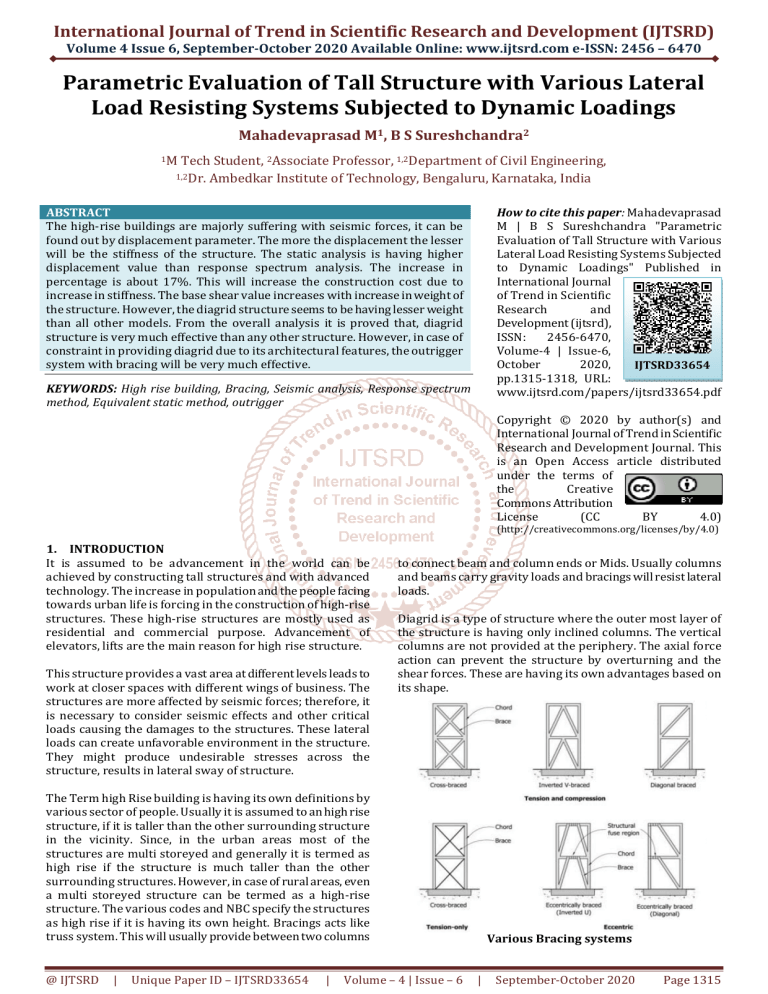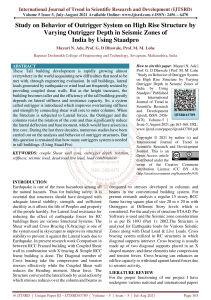
International Journal of Trend in Scientific Research and Development (IJTSRD)
Volume 4 Issue 6, September-October 2020 Available Online: www.ijtsrd.com e-ISSN: 2456 – 6470
Parametric Evaluation of Tall Structure with Various Lateral
Load Resisting Systems Subjected to Dynamic Loadings
Mahadevaprasad M1, B S Sureshchandra2
1M
Tech Student, 2Associate Professor, 1,2Department of Civil Engineering,
1,2Dr. Ambedkar Institute of Technology, Bengaluru, Karnataka, India
How to cite this paper: Mahadevaprasad
M | B S Sureshchandra "Parametric
Evaluation of Tall Structure with Various
Lateral Load Resisting Systems Subjected
to Dynamic Loadings" Published in
International Journal
of Trend in Scientific
Research
and
Development (ijtsrd),
ISSN:
2456-6470,
Volume-4 | Issue-6,
October
2020,
IJTSRD33654
pp.1315-1318, URL:
www.ijtsrd.com/papers/ijtsrd33654.pdf
ABSTRACT
The high-rise buildings are majorly suffering with seismic forces, it can be
found out by displacement parameter. The more the displacement the lesser
will be the stiffness of the structure. The static analysis is having higher
displacement value than response spectrum analysis. The increase in
percentage is about 17%. This will increase the construction cost due to
increase in stiffness. The base shear value increases with increase in weight of
the structure. However, the diagrid structure seems to be having lesser weight
than all other models. From the overall analysis it is proved that, diagrid
structure is very much effective than any other structure. However, in case of
constraint in providing diagrid due to its architectural features, the outrigger
system with bracing will be very much effective.
KEYWORDS: High rise building, Bracing, Seismic analysis, Response spectrum
method, Equivalent static method, outrigger
Copyright © 2020 by author(s) and
International Journal of Trend in Scientific
Research and Development Journal. This
is an Open Access article distributed
under the terms of
the
Creative
Commons Attribution
License
(CC
BY
4.0)
(http://creativecommons.org/licenses/by/4.0)
1. INTRODUCTION
It is assumed to be advancement in the world can be
achieved by constructing tall structures and with advanced
technology. The increase in population and the people facing
towards urban life is forcing in the construction of high-rise
structures. These high-rise structures are mostly used as
residential and commercial purpose. Advancement of
elevators, lifts are the main reason for high rise structure.
This structure provides a vast area at different levels leads to
work at closer spaces with different wings of business. The
structures are more affected by seismic forces; therefore, it
is necessary to consider seismic effects and other critical
loads causing the damages to the structures. These lateral
loads can create unfavorable environment in the structure.
They might produce undesirable stresses across the
structure, results in lateral sway of structure.
to connect beam and column ends or Mids. Usually columns
and beams carry gravity loads and bracings will resist lateral
loads.
Diagrid is a type of structure where the outer most layer of
the structure is having only inclined columns. The vertical
columns are not provided at the periphery. The axial force
action can prevent the structure by overturning and the
shear forces. These are having its own advantages based on
its shape.
The Term high Rise building is having its own definitions by
various sector of people. Usually it is assumed to an high rise
structure, if it is taller than the other surrounding structure
in the vicinity. Since, in the urban areas most of the
structures are multi storeyed and generally it is termed as
high rise if the structure is much taller than the other
surrounding structures. However, in case of rural areas, even
a multi storeyed structure can be termed as a high-rise
structure. The various codes and NBC specify the structures
as high rise if it is having its own height. Bracings acts like
truss system. This will usually provide between two columns
@ IJTSRD
|
Unique Paper ID – IJTSRD33654
|
Volume – 4 | Issue – 6
Various Bracing systems
|
September-October 2020
Page 1315
International Journal of Trend in Scientific Research and Development (IJTSRD) @ www.ijtsrd.com eISSN: 2456-6470
Outriggers structure system
2. OBJECTIVES
A. To understand the seismic resistant behaviour of
following structures.
Model 1- High rise structure with Bare frame system.
Model 2- High rise structure with Bracing system
Model 3- High rise structure with Outrigger system
Model 4- High rise structure with both Bracing and outrigger
Model 5- High rise structure with both Outrigger system and
Belt truss
Model 6- High Rise Diagrid System
Seismic and Model Parameters
B. To understand the structure is subjected to static and
dynamic behaviour of structures.
C.
The analysis is carried out for the particular seismic
zones to check the variations in the response.
D. The results in terms of base shear, displacement, storey
drift, and time period are compared and discussed.
3. METHODOLOGY
To carryout expensive literature review, to establish the
objective of the study.Etabs software is used for the
modeling and analysis of different building configurations.
Analyse the model using all major Static (Equivalent static
analysis) and Dynamic analysis using IS1893-2016. Concrete
mix of M35 grade, reinforcing steel of Fe500 and structural
steel of Fe450 will be consider for the analysis of the
structural system. Preliminary member sizes are assumed
for beams and columns , later member sizes are economized
and based on the system adopted. Conclusions are made
based on the performance of each system under study.
Plan View
4. MODELING
The proposed models are structural steel. The model is 45
storey height with regular shaped structure. The below
Table 4-1 shows material properties and design parameters
used in this project.
3D View
@ IJTSRD
|
Unique Paper ID – IJTSRD33654
|
Volume – 4 | Issue – 6
|
September-October 2020
Page 1316
International Journal of Trend in Scientific Research and Development (IJTSRD) @ www.ijtsrd.com eISSN: 2456-6470
Mode numbers v/s time period _ Modal Analysis
Elevation View
5. RESULT
A. Equivalent Static Analysis:(ESA)
Comparison of base shear v/s models of 45 storeys
B. Response Spectrum Analysis: (SPECX)
Storey v/s displacement _ Static Analysis
Storey v/s displacement _ Dynamic Analysis
Storey v/s storey drifts _ Static Analysis
Storey v/s storey drifts _ Dynamic Analysis
@ IJTSRD
|
Unique Paper ID – IJTSRD33654
|
Volume – 4 | Issue – 6
|
September-October 2020
Page 1317
International Journal of Trend in Scientific Research and Development (IJTSRD) @ www.ijtsrd.com eISSN: 2456-6470
6. CONCLUSION
A. The high-rise buildings are majorly suffering with
seismic forces, it can be found out by displacement
parameter. The more the displacement the lesser will be
the stiffness of the structure.
B. The static analysis is having higher displacement value
than response spectrum analysis. The increase in
percentage is about 17%. This will increase the
construction cost due to increase in stiffness.
C. The drift values are found satisfactory, since the values
are lesser than limiting i.e., h/250 = 3000/250 = 12.
Hence, these models are preferred in zone 3 as
considered.
D. The drift values are lesser in case of dynamic analysis
than static analysis.
E. From the modal analysis, it is clear that, the models 1 is
more flexible than all other models. However, the Model
M6 with diagrid section is brittle compared to all other
models.
F. The time period in model M6 is greatly reduces than all
other models. However, the decease in percentage is 9%,
3%, 13%, 4% and 59% for models M2, M3, M4, M5 and
M6 when compared with model M1.
G. The base shear values of model M6 is very much lesser
compared to other models. The model Model M5 is
having more base shear value than other models.
H. The base shear value increases with increase in weight
of the structure. However, the diagrid structure seems to
be having lesser weight than all other models.
I. The time period and base shear values of models
depends only on building dimensions and weight and
hence it does not vary for type of analysis.
@ IJTSRD
|
Unique Paper ID – IJTSRD33654
|
REFERENCES
[1] IS1893:2016 – Criteria for Earthquake Resistant
Design of Structures. Part 1.
[2]
JolantaTamošaitienėa,*,
ErnestasGaudutisb,
ModestasKračka, “Integrated Model for Assessment of
High-Rise Building Locations”.
[3]
Dhanaraj M. Patila, Keshav K. Sangle, “Seismic
behaviour of outrigger braced systems in high rise 2D steel buildings”.
[4]
Manish K. Changwadiya1, Prof. Vimlesh A. Agrawal2,
Prof. Atul N. Desai, “Effect of Mega Column in
Outrigger System of High-Rise Building”.
[5]
Dhanaraj M. Patil, Keshav K. Sangle, “Seismic
Behaviour of Different Bracing Systems in High Rise
2-D Steel Buildings”.
[6]
E. BrunesiR. Nascimbene, L. Casagrande, “Seismic
analysis of high-rise mega-braced frame-core
buildings”.
[7]
KavitaB.Sagare1, Dr. UttamKalwane, “Improvement in
Seismic Performance of Multistoried Building Using
Metallic Bracing”.
[8]
MridulRawat, 2Ankush Kumar Jain, “Effects of Various
Bracing Angles on Steel Diagrid Building: An
Analytical Approach”.
[9]
KhushbuJania, Paresh V. Patel, “Analysis and Design of
Diagrid Structural System for High Rise Steel
Building”.
[10]
AjinkyaPrashantGadkari, 2N. G. Gore, “Review on
Behaviour of Outrigger Structural System in High-Rise
Building”.
Volume – 4 | Issue – 6
|
September-October 2020
Page 1318






